Rented garden ideas – create a beautiful garden in pots!
If you have a rented garden or can’t afford to change your landscaping, then you can create a real garden in pots.
When you move, you can take the pots with you. You can even replant the plants in the soil after a few years in pots.
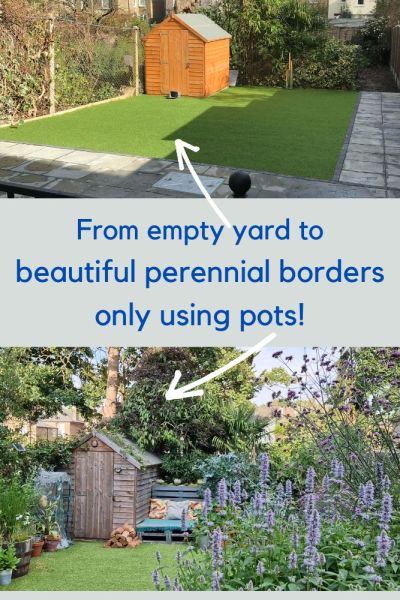
Shaun transformed an empty yard with artificial turf and pavers into a wildlife-friendly perennial haven only using pots.
But making a whole garden out of pots is a different from using pots to create focal points or to create a display on a terrace.
Garden designer Shaun Mooney of Potwell UK lives in a rented garden himself. He has created a stunning perennial garden entirely out of containers, even though the garden has no access to bare soil at all. Although he also designs larger gardens, he’s worked on a number of balconies and rented gardens, so he knows from experience what the issues are.
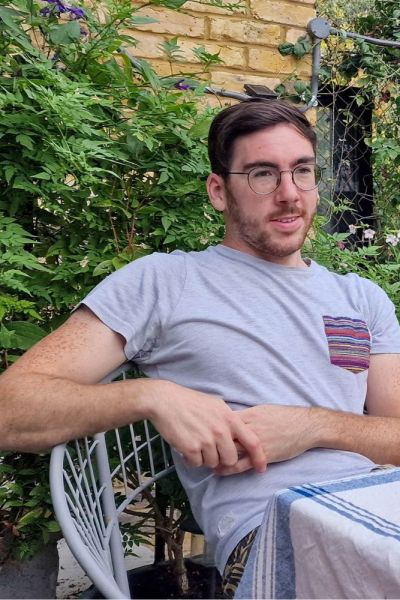
Garden designer Shaun Mooney of Potwell UK. As well as designing gardens and balconies, Shaun also does consultations by the hour for those who don’t want a complete re-design or who just want general advice (for example, on pots).
And although Shaun’s garden has both artificial grass and pavers, neither of which are good for wildlife and both of which have environmental issues, he has created a wildlife-friendly haven with light environmental footprint.
Rented garden tips
- You’ll need lots of compost. Buy it in bulk to save money
- Put your special pots in the front where they can be seen, cheaper pots can be hidden
- Larger containers need less watering than smaller ones.
- Get troughs and containers made to measure to achieve non-standard heights.
- Recycle tins and pallets to make planters and furniture
- Plan heights as you would in a border, with tall, medium and shorter plants
- ‘Fill in the corners’ – add extra planting to mask a square or rectangular shape
- If you have no access to soil for a compost bin, use a wormery
- Add a mini pond in a pot or barrel to support wildlife
- Plants in pots need regular watering, so look for plants with some drought resistant
- Some garden designers do consultations by the hour and can help with choosing plants for pots
- Most plants can be grown in pots, but expect a few disappointments
- Even if you can’t make choices about your hard landscaping, you can still maximise being wildlife-friendly and eco-friendly.
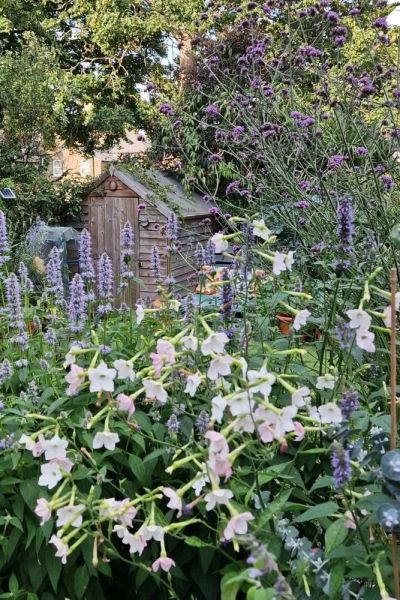
It’s hard to believe that you can get so many flowers and so much abundance when Shaun has no access to the soil at all! This is Nicotiana ‘Whisper Mix’, Agastache ‘Blackadder’ and Verbena bonariensis.
Start a rented garden with the soil
There may be no access to the soil at all with a rented garden. Shaun’s landlord created a patio plus a square of artificial grass, so there was no bare soil anywhere. Shaun doesn’t like the artificial grass, but he can’t change it. (For the pros and cons of various lawns and artificial grass, see Do You Really Need a Perfect Lawn.)
You need to think about what the plants are going to grow in. If you have lots of pots, you’ll need to buy lots of potting compost and that gets expensive. Shaun advises ordering the compost in bulk, because that is cheaper per pot. You only need to do that in the beginning. Shaun then only adds a fresh topping of compost and a mulch twice a year.
If you’re going to grow plants that prefer acid soil, such as azaleas and rhododendrons, you’ll need to buy ericaceous compost.
If you do have access to bare soil, there may be restrictions on what you can plant in your lease. You’ll often have to get your landlord’s permission to plant. Or you may be required to leave your rented garden or home in the same condition it was in when you moved in. However, you can often dig plants up when you move.
You’ll need lots of pots…ways of minimising their cost
Shaun collects a particular speckled glaze type of pot. They are the most expensive containers in his garden, so he makes the most of them by putting them at the front of a pot grouping or on their own. Then he uses cheaper terracotta pots from the DIY store at the back or where there will be covered by foliage.
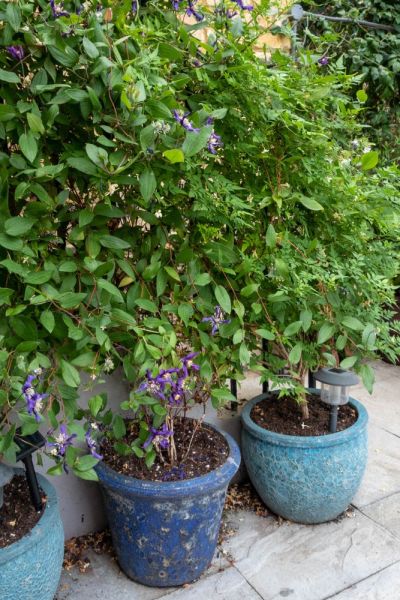
If you collect a particular style or look of pot, then you can grow a collection slowly as you can afford it. Shaun puts his best pots on display, and hides the cheaper terracotta ones in the back of the border.
He has also had troughs made to measure via a maker on Ebay. You can put ‘troughs made to measure near me’ into a search engine and lots of options come up.
Having a trough made may seem expensive, but you can plant lots of plants in one trough. Larger containers also retain water better than smaller ones, so you will find it easier to look after a plants in one trough than it is to look after a group of plants in pots.
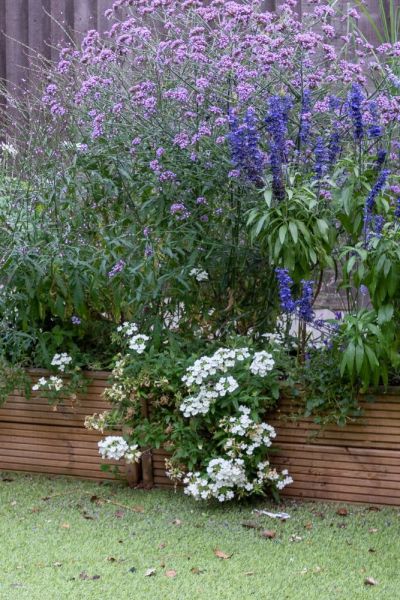
The troughs that form the structure of the garden design are narrow and deep, so they hold lots of compost. These ones extend in a L shape to enclose the area.
Shaun also recycles containers where he can. His partner, Danny, comes from Galicia in Spain, where there are excellent crisps in large tins. He drills holes in the bottom of the tins and uses them for herbs.
And the bulk compost he ordered came in big sacks on pallets, so Shaun and Danny made a pallet sofa with a planter at the back.
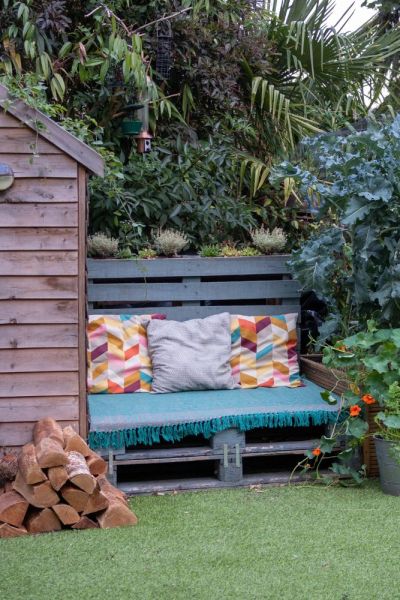
Shaun re-used pallets from bulk compost buys to make a sofa-cum-planter. You can see the succulents planted along the back of the sofa.
Designing a planter garden
Shaun used the same principles for designing a planter border as he would for a herbaceous border in soil. He has planted larger plants at the back and medium height or shorter ones at the front. One of the trough planters even has two heights, and the other is L shaped. Both approximate the shape of a border rather than the shape of a pot.
The garden is a small rectangular space, so Shaun advises ‘filling in the corners.’ In this garden, this means planting lavish groups of plants on two of the corners of the artificial grass. It helps cover the grass and also softens the angles. It also gives a sense of ‘reveal’ – you can’t quite see all the garden at once.
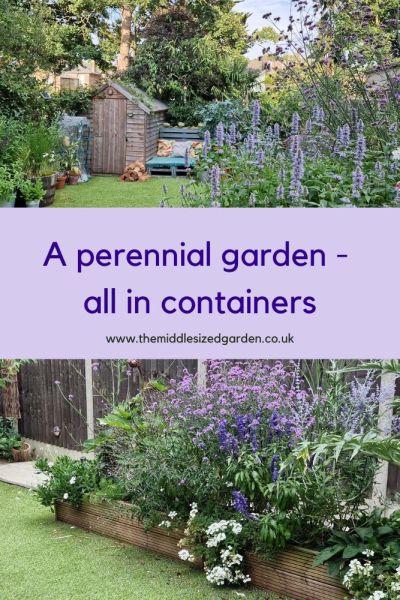
Shaun ‘softened the corners’ of the bare rectangular space by adding extra pots and containers full of perennial plants.
Climbers and pots
Shaun has softened some stair rails by covering them with three climbers in pots. He says that the climbers are harder to grow in pots than some of the other perennial plants, but at least he’s not trying to grow them too high. He gives them extra fertiliser and water.
When he moves, he will cut away the parts of the climber that are entwined with the stair rails. He then hopes to be able to plant them in the ground in a new home.
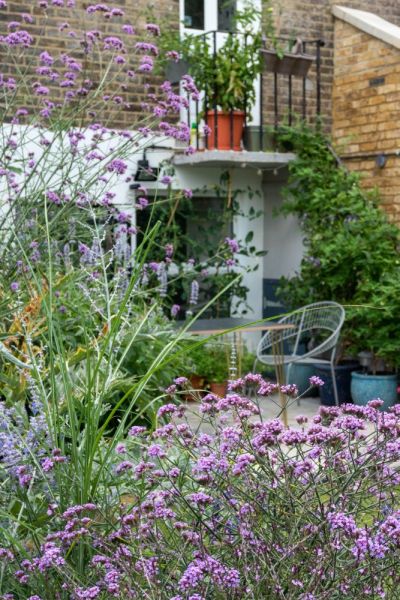
Shaun created a sense of greenery by using climbers in pots up the staircase. It really is hard to believe that everything you see growing is in pots.
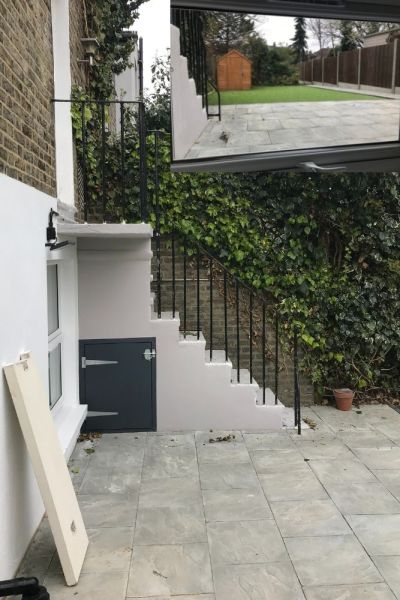
This picture (and the inset) shows what the terrace was like when Shaun moved in.
A mini pond in a rented garden
Access to water is vital for wildlife, so Shaun made a mini pond in a barrel. There is a river not far away, so frogs have found their way to his pond, and dragonflies too.
You can find instructions for making a mini pond in a barrel or container here.
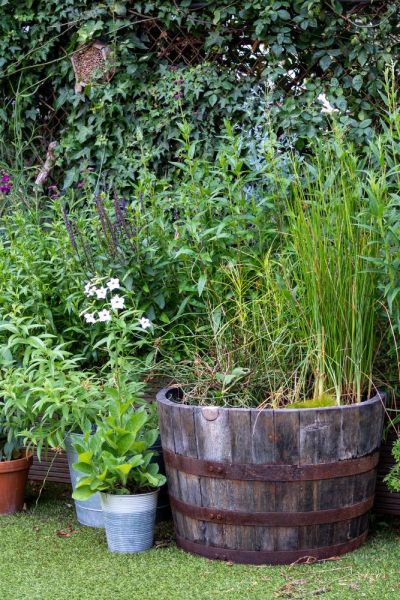
Shaun’s mini wildlife pond
If you have a rented garden, then moving a mini pond is going to be a little more difficult. However, you should be able to preserve most of the life in the pond by transferring it to buckets, then you can re-constitute the pond in your new home. Don’t try to move it when it’s full of water as it will be very heavy and may break apart.
Looking after a garden in pots
Pots and containers get all their water and nutrition from you. The roots have no access to the ground. So you will have to water at least twice weekly during the summer. You will probably have to water daily in the hottest weather.
Shaun says that you should give each pot plenty of water, not just a sprinkle. The water should soak it thoroughly until it starts to drain out of the bottom of the pot.
You also need to feed pots regularly in the growing season. Shaun feeds his by using a wormery. He recycles food waste in two wormery bins. One of the wormery bins is in a planter where he grows vegetables. The other creates worm compost and worm fertiliser tea for the rest of his garden.
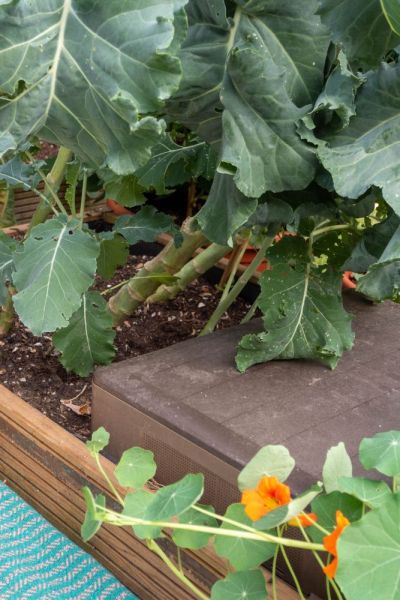
This wormery is incorporated with a planter, where Shaun grows vegetables. You lift the lid to throw away food scraps (not meat, fish or oils).
The reason why Shaun uses a wormery is that he has no access to the soil for a compost bin, so this is a good idea for those with small courtyards or balconies.
If you don’t make your own fertiliser, you can buy them. Fertiliser brands and instructions vary – you can buy liquid seaweed feeds to use weekly or longer term fertilisers.
You can be eco-friendly in a rented garden
There is currently a huge debate over the use of artificial grass and other hard landscaping materials and the damage they cause to the environment. Artificial grass and other materials are particularly bad for worms and soil micro-organisms, because they effectively seal off the soil. They don’t offer food for birds or pollinators. And depending on what you use and how it’s laid, they also contribute to flash flooding and they over-heat in hot weather, adding to the effects of heatwaves in hot weather. On top of that is what they are all made of and how.
A recent symposium on garden design and sustainability, held at RHS Wisley by the Society of Garden Designers concluded that while artificial grass is the most environmentally damaging of the hard landscaping materials, all hard landscaping has an environmental impact. They recommended reducing hard landscaping generally rather than focusing one particular type. However, if you have a rented garden, you can’t make those choices yourself.
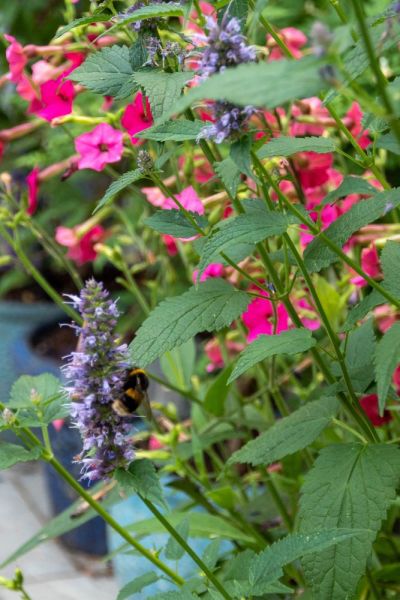
Shaun plants flowers that are useful to a wide range of pollinators. This Agastache ‘Blackadder’ flowers all summer and attracts a wide range of bees. Nicotiana ‘Whisper Mix’ is usually pollinated by moths, but Shaun has seen bumble bees nip off the base of the flower to get at the nectar.
Garden designer Marian Boswell suggests you ask three questions of any material you are going to install: can you re-use what you already have, how far does anything new have to be transported and what will happen to any material you buy in a 100 years time?
So although this garden is completely covered in pavers and artificial grass, Shaun has turned it into a very eco-friendly and wildlife-friendly haven. He has reused tins and pallets, created a wildlife pond, he only buys peat-free compost, he chooses pollinator-friendly planting and all his fertiliser is made in their own garden wormery from their food waste. It shows that you can balance out the least eco-friendly garden and work it in a more environmentally friendly way.
The garden itself was buzzing with bees, pollinators and dragonflies. I even heard a frog croak in the mini pond.
More container planting tips
There are more tips on grouping pots from Dan Cooper here. And Danish gardening influencer Claus Dalby show you how to create a colourful dahlia border in pots here.
To keep your rented garden looking good all winter, here are tips on creating brilliant winter pots and containers.
And if you want a pot garden, but don’t the work of looking after flowers, then here is how to create an year-round display with evergreen pots.
Matthew Pottage of the RHS has written a book called RHS How To Garden if You Rent. It’s sub-titled ‘make it your own, keep your landlord happy’ and it’s a practical how-to to make the most of the smallest rented outdoor space. It’s one of the Middlesized Garden best gardening books of the year.
Pin to remember rented garden ideas
And do join us for a free weekly email with gardening tips, ideas and inspiration.
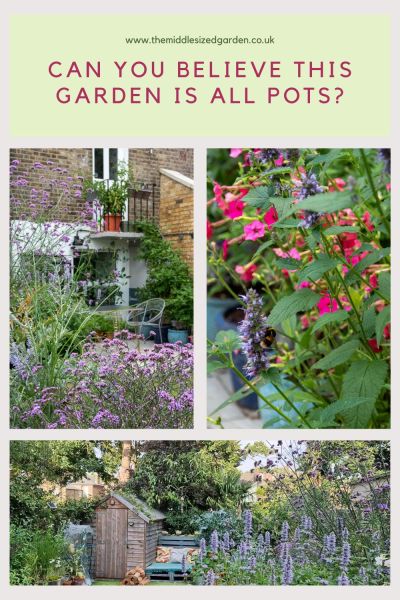
























Inspirational! Really enjoyed this feature. It just goes to show, a garden, however problematic, is for all.
Could we have a blow by blow account of how to make the wormery please. I have pallets available!
I’ve sent you a separate email with some tips, but just to say here that the pallet sofa and planter is next to the wormery – the wormery is separate inside another planter.
I loved this article it was inspirational, informative and achievable, thank you
Thank you!